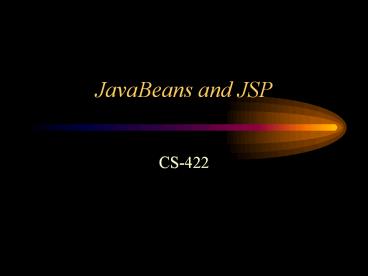JavaBeans and JSP - PowerPoint PPT Presentation
Title:
JavaBeans and JSP
Description:
JavaBeans and JSP CS-422 JavaBeans The ... their own persistence this allows the bean to be saved and restored consistently provide a no ... in the whole we ll take ... – PowerPoint PPT presentation
Number of Views:68
Avg rating:3.0/5.0
Title: JavaBeans and JSP
1
JavaBeans and JSP
- CS-422
2
JavaBeans
- The Java component technology
- originally intended for the creation and
management of pluggable GUI components Javas
answer to Visual Basics VBX/OCXs - becoming more popular for encapsulating business
logic for server-side applications (especially
Java Server Pages - many Java GUI Development tools have been
modified to allow application development of
server-side applications (Visual Café, Jbuilder,
VisualAge for Java) along with the development
tools being delivered with application servers
(SilverStream, BEA Weblogic) - A JavaBean is nothing more than a class that
maintains some state data (called properties) and
follows a certain set of coding conventions.
Along with certain Java runtime support
(reflection and introspection) can JavaBeans can
be easily added to and maintained by most of the
Java GUI Development Tools .
3
API requires that
- Must implement java.io.Serializable or
java.io.Externalizable - Beans must be able to support their own
persistence - this allows the bean to be saved and restored
consistently - provide a no-arguments constructor
- provides a single way for the Bean to be
instantiated - insures consistent bean creation and
initialization - private properties must have corresponding
get/set methods that follow the appropriate
naming patterns - each piece of state data to be exposed is called
a property - made public via accessor and mutators (setters
and getters) - accessor methos names must start with get
- for property int color the accessor would be
getcolor() - mutator methods names must start with set
- for property fuelCapacity the mutator would be
setfuelCapacity()
4
Environmental Support
- To use JavaBeans with JSP no environmental
support is needed, but for a better understanding
of JavaBeans in the whole well take a look - Introspection ( java.beans.Introspector) defines
the resources that allow the programatic
construction of information on the Bean - facilitates the discovery of properties and
methods by inspecting the .class file - can be done two ways the reflection APIs or by
providing a java.beans.BeanInfo class with the
bean to describe the public methods and
properties, - Reflection (java.lang.reflect) a set of resources
that allows a program to discover the public
properties and methods of classes that have been
loaded by the class loader - this is facilitated by the naming convention for
accessors and mutators (i.e. the names must start
with get or set) - dont need to need to knownames of properties as
long as we know the names of the accessor and
mutators - These environmental support mechanisma allow the
JavaBeans to be cleanly integrated into GUI
based, Java Development tools like VisualCafe,
VisualAge and Jbuilder.
5
Example a Stock bean
import java.io.Serializable public class Stock
implements Serializable Stock( ) // no
argument constructor (just creates the object)
private String name null private String
tickerSymbol null private double
tradingPrice 0.0 private double
sharesOwned 0.0 public void setName(String
n) name n public String getName( )
return name public void setTickerSymbol(
String s ) tickerSymbol s public
String gettickerSymbol( ) return tickerSymbol
public void settradingPrice( double d )
tradingPrice d public double
gettradingPrice( ) return tradingPrice
public void setsharesOwned( double v )
sharesOwned v public double
getsharesOwned( ) return sharesOwned
6
jspuseBean Tag
- jspuseBean does the following
- If the object is found within the specified scope
it is retrieved and assigned to the object - if not found it is instantiated
- if newly instantiated it executes the code
specified in the body ( one or more
jspsetProperty tags or a scriptlet) - if newly instantiated it is saved into the scope
via setAttribute( ) method - jspuseBean also makes the bean visible to the
JSP there may be other objects in the context
that were put there by other JSPs or servlets
jspuseBean can make them visible to the current
JSP
7
jspuseBean Tag (more)
- Attributes
- id
- scope
- class
- beanName
- type
- ltjspuseBean id today class java.util.Dategt
- instantiates a bean called today of class
java.util.Date( ) - ltjspuseBean id count class
java.lang.Integer type java.lang.Numbergt - essentially does Number count count new
Integer( ) - ltjspuseBean id count class lt
request.getParameter(beanName)gt type
Number /gt - essentiallt does Number count count
java.beans.Beans.instantiate(request.getParameter(
beanName))
8
jspuseBean Tag (more)
- In general the syntax is
ltjspuseBean id name scope page request
session application
class class name class class
name type type name beanName
bean name type type name type
type name /gt































